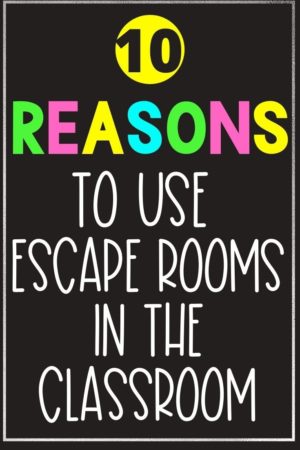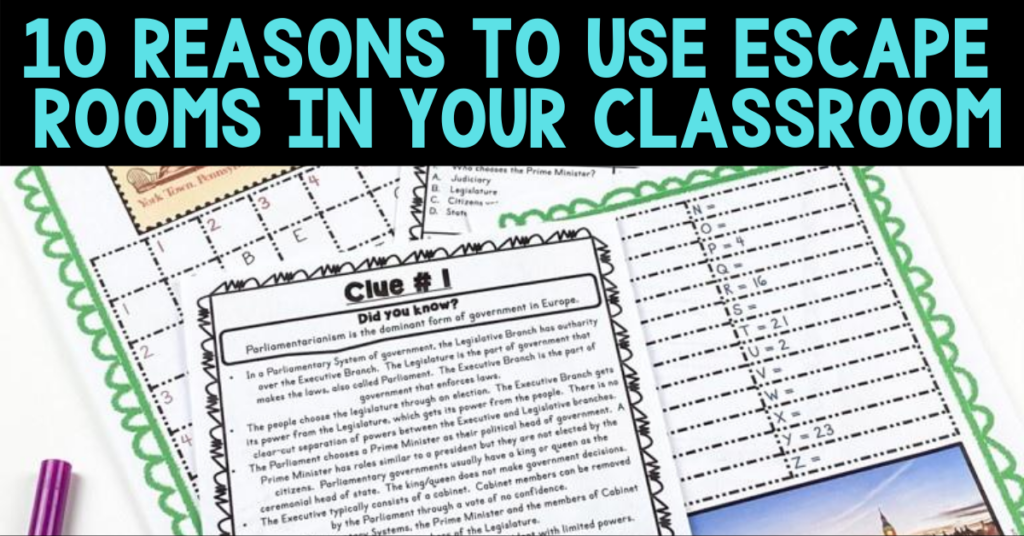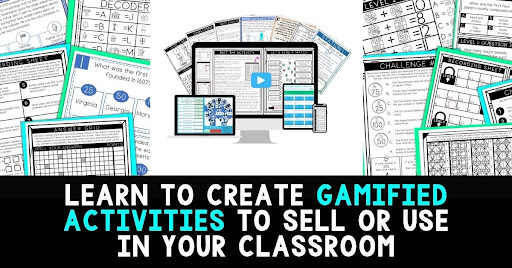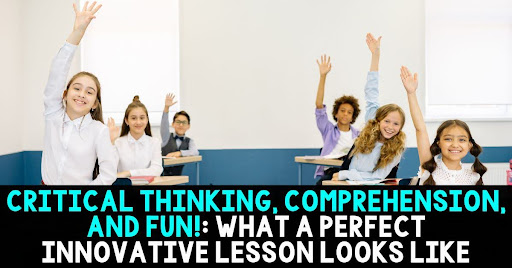Creating an escape room in the classroom has been a game changer. I often find myself in front of my class reaching maybe 80% of my students… if I am lucky!
For years I have been researching and building into my lesson plans various techniques and strategies for getting students attention. I attempt to leverage different communication styles to make sure I meet my students on each of their individual learning levels.
My lesson plans, I believe, are fun and interactive. However, there is always that handful of students that just won’t participate no matter what I do.
Until I discovered Escape Rooms for the classroom!
Escape Rooms skyrocketed in popularity just a few short years ago. There are three Escape Rooms within fifteen minutes of my house. My family had to make reservations a week in advance to get in there for an hour to play!
The theme of the first one I participated in with my kids was set in the 1920’s and centered around the mafia. We had a blast and managed to escape. I left there feeling like this was a successful parenting experience because every single family member had a blast! It wasn’t until later that evening that an idea started to form in my head.
Something amazing happened at dinner on the day that we had escaped from the Mafia in the 1920’s. My children were still so engaged in the Escape Room experience that they could not stop talking about it!
They talked about the room we were in, the story that had been told, the clothing on the people hanging on pictures on the wall, the room decorations, etc. I listened as they had a great conversation.
The Great Idea!
My students started asking questions and wanted to learn more about the history of that era. This led to a fantastic discussion about the Great Depression, something my kids knew nothing about.
We spent the next hour talking about everything from what the world was like before modern technology, how people dressed. We even discussed the differences in how families ate dinner together in that crazy extra room no one uses nowadays - the dining room.
That is when I had my “ah ha” moment! I thought to myself that just maybe using an Escape Room in my classroom would be the thing that gets every student engaged.
If I could create an experience based on the topic we were learning about, maybe it would peak their interest and create a little passion. Excitingly, I was right! Every single student participated.
It brings students together
Kids that have never even made eye contact in my classroom were now standing shoulder to shoulder excitingly racing against the clock to win!
As I listened to the conversations going on around me, I noticed numerous things. The first thing I noticed was the social aspect of the game. I could see leaders emerging, and problem solvers coming forward with ideas.
Wheels were turning in my student's minds as they developed their critical thinking skills. It was so much better than giving notes to memorize.
I was teaching them how to see a problem or a puzzle and come up with a solution on their own. I wasn’t just giving them answers, I was teaching them to find the answers for themselves!
So then I came up with lots of other escape room ideas to use in the classroom.
You could create your own escape rooms like these using facts about space, animals and geography.
Why you should use escape rooms in your classroom
There are a number of advantages to utilizing an Escape Room in your classroom. I would highly recommend it to all teaching professionals!
For those teachers still on the fence, I thought I would offer a list of the top 10 advantages. I discovered these after implementing them into lesson plans in my classroom.
If you are looking to implement strategies for getting students attention, this should be top of your list!
10 Reasons to use Escape Rooms in the Classroom
1. Teamwork and social integration
Escape Rooms encourage teamwork that transcends social circles in the classroom.
Every student wants to escape and will discuss their escape plans openly.
2. Makes a boring topic exciting!
Total immersion in the Escape Room experience provided valuable lessons that traditionally were considered boring.
I have found that if I tell my class that we will be doing an Escape Room in order to apply information we are learning about, they are more excited about the lesson being taught.
3. Engagement, engagement, engagement
Adding a framework of a game on top of a mundane lesson significantly increases engagement and retention.
Students may not remember a definition that they had previously memorized, but when they recall the lesson from the Escape Room, they will easily recall the keywords and visual images they used to escape.

4. Escape Rooms cover all learning styles.
One of the top reasons this is one of the best Strategies for getting students attention, it covers all learning styles.
Visual, auditory, reading/writing, and kinesthetic learning styles are all integrated while the students are using every avenue to try and solve the puzzles.
5. Outside of the box thinking.
A well done Escape Room starts with an easier puzzle to create confidence in the students and as the game moves on, the puzzles get harder.
This is one of my top strategies for getting students attention. By the end of the game, the students need to use higher level thinking in order to solve the final puzzles.
With their confidence being built early on in the game, they feel capable of this higher level thinking and can deduce ideas to succeed.
6. Escape Room games can accommodate many different lessons and topics.
As an example, one of my NO PREP Escape Rooms focuses on the U.S. Constitution. Within this adventure, there is a code written in which the students need to use deductive reasoning to spell out words and interpret information.
Not only are they learning the history aspect, but they are also using their language arts skills in the same lesson!
7. Students must apply, analyze AND synthesize information.
They are not given definitions to memorize and regurgitate. They are given information that they need to analyze, multiple facets that they need to synthesize, and finally they need to apply what this information has lead them to.
8. A timed challenge encourages the students to work without distraction.
Have you ever asked your students to complete a task within the class period? I have, and honestly, those are some of my most frustrating lessons!
I am constantly trying to re-engage the students in their work. “You need to get back on task” is the most repeated sentence of my day. With an Escape Room, however, the students are engaged and excited. They are committed to escaping from the imaginary scenario that I have created.
9. Escape rooms require very little guidance once started.
At times, students can be unsure about what to do. But a little nudge can get them right back to being invested in this lesson.
There are many teachable moments that can be taken advantage of during an Escape Room activity. For the most part, you can set the timer and watch the wheels start turning!
10. Escape rooms are FUN, FUN, FUN!
It honestly still makes my heart full! Just thinking about what offering an Escape Room in my class has done for the learning environment. It taught the lesson in an engaging way which provided movement around the classroom but it brought these kids together.
The students learned to work with one another, while learning important facts and using critical thinking skills to escape. To me, an Escape Room is a win-win for everyone!
HAPPY CODE BREAKING!
If you're looking for more ways to keep your students engaged, why not take a look at some of my other posts?
U.S. Constitution Resources Your Students Will Love, Virtual Field Trips For Your Remote Social Studies Classroom and How To Create A Better Experience For Students In Your Science Class
related posts

hey there!
Grab a Free Growth Mindset Escape Room for grades 4-8.
LOOKING FOR
something?
Legal Stuff
.01 Terms & Conditions
.02 Disclaimer
.03 Privacy Policy
.04 Membership Terms
.05 Log into your account
BECOME A
member
Choose from 3000+ resources with a monthly or yearly Think Tank membership plan. New resources are added every month. Double or even TRIPLE your purchases with Think Tank credits. Cancel any time!
WANT MORE FREEBIES?
let's be email buddies
Freebies, teaching tips and coupons delivered straight to your inbox.




